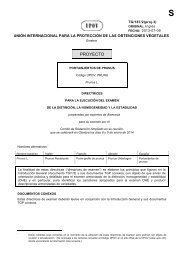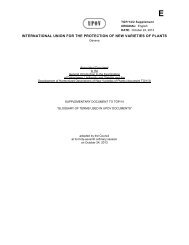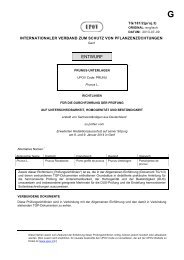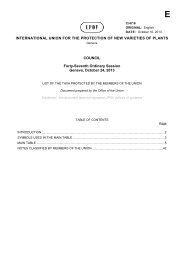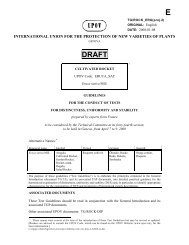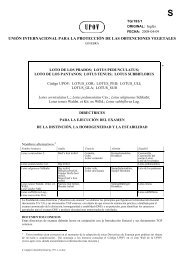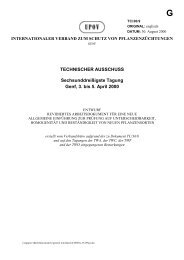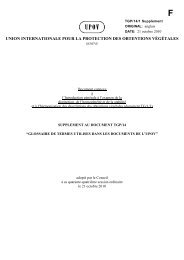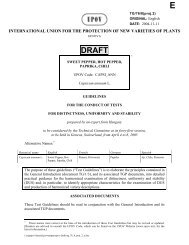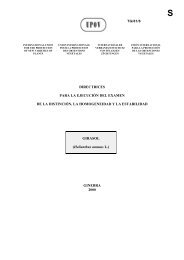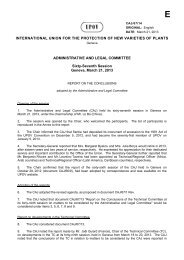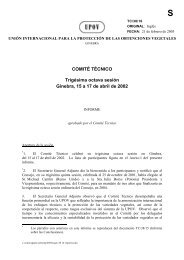E - International Union for the Protection of New Varieties of Plants
E - International Union for the Protection of New Varieties of Plants
E - International Union for the Protection of New Varieties of Plants
You also want an ePaper? Increase the reach of your titles
YUMPU automatically turns print PDFs into web optimized ePapers that Google loves.
TGP/14/1: Section 2: Botanical Terms<br />
Subsection 2: Shapes and Structures: III. DEFINITIONS FOR SHAPE AND STRUCTURE TERMS<br />
page 64<br />
Term<br />
Emarginate<br />
Entire<br />
Equilateral<br />
Erect<br />
Erose<br />
Even<br />
Exserted<br />
Falcate<br />
Farinaceous<br />
(Farinose)<br />
Fasciated<br />
Fastigiate<br />
Felted<br />
Fibrous<br />
Fili<strong>for</strong>m<br />
Fimbriate<br />
Fine<br />
Flabellate<br />
(fan shape)<br />
Definition / comment<br />
Notched; with an acute, deep, central sinus. Applies to <strong>the</strong> apex. Compare<br />
‘retuse’ and ‘obcordate’.<br />
With an undivided margin; not too<strong>the</strong>d or lobed.<br />
With sides or halves <strong>of</strong> equal shape and/or size. Compare ‘inequilateral’.<br />
Vertical in relation to <strong>the</strong> ground or perpendicular to <strong>the</strong> surface where <strong>the</strong> plant<br />
part is attached.<br />
For UPOV purposes ‘erect’ is used <strong>for</strong> plant parts only (attitude) and not <strong>for</strong> <strong>the</strong><br />
whole plant (habit). The term to be used <strong>for</strong> plant habit is ‘upright’.<br />
Gnawed; with an irregularly too<strong>the</strong>d margin, as if chewed.<br />
Smooth; opposite <strong>of</strong> rough. For internal texture characteristics <strong>the</strong> term ‘fine’ is<br />
used.<br />
Extending beyond <strong>the</strong> surrounding parts, e.g. stamens protruding beyond <strong>the</strong><br />
corolla. Compare ‘included’.<br />
Sickle-shaped; strongly curved sideways.<br />
Mealy; with a whitish, powdery covering. Compare ‘granular’.<br />
With stems fused toge<strong>the</strong>r and congested lengthwise, mal<strong>for</strong>med and flattened; e.g.<br />
stems <strong>of</strong> pea.<br />
Strongly upright, with a narrow crown, <strong>the</strong> branches virtually erect, parallel and<br />
adpressed. Applies to trees. Compare ‘columnar’ <strong>of</strong> which <strong>the</strong> branch<br />
development is suppressed.<br />
use ‘pannose’.<br />
With tough strands.<br />
‘Thread-like’.<br />
Bearing a marginal fringe <strong>of</strong> hair-like appendages extending not only from <strong>the</strong><br />
epidermis but from <strong>the</strong> deeper layers as well. Compare ‘ciliate’ which arises from<br />
<strong>the</strong> epidermis only.<br />
Not textured; smooth, opposite <strong>of</strong> ‘rough’. For surface characteristics <strong>the</strong> term<br />
‘smooth’ or ‘even’ is used.<br />
Fan shaped; rounded at <strong>the</strong> apex and flattened at <strong>the</strong> base.<br />
Fleshy<br />
Pulpy; succulent but firm, easy to cut.<br />
Flexuous (a) Resiliently bendable, like a whip / li<strong>the</strong> or fluid in movement; or<br />
(b) Having curves, turns or bends<br />
Floccose Covered by <strong>the</strong> general term “hair” in <strong>the</strong> Test Guidelines. With tufts <strong>of</strong> long, s<strong>of</strong>t<br />
hairs, usually rubbing <strong>of</strong>f easily.’<br />
Form<br />
in <strong>the</strong> UPOV Test Guidelines, <strong>the</strong> term “shape” should be used in its broadest<br />
sense and <strong>the</strong> use <strong>of</strong> terms such as “<strong>for</strong>m” and “pr<strong>of</strong>ile” should be avoided to<br />
minimize discrepancies in translation<br />
Free<br />
Separate from one ano<strong>the</strong>r; not joined.<br />
Funnel-Shaped<br />
(Infundibular)<br />
Fusi<strong>for</strong>m<br />
With an obconic tube gradually diverging distally. Compare ‘campanulate’ and<br />
‘cup-shaped’ which are rounded basally.<br />
Spindle-shaped; long and narrow, circular in transverse section, thick in <strong>the</strong> middle<br />
and tapering to both ends.



